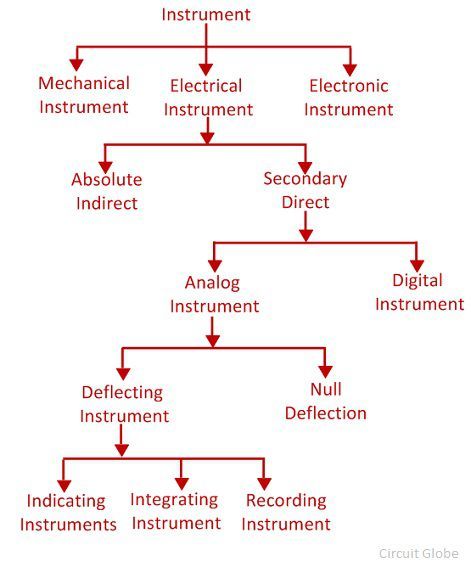The instrument used for measuring the physical and electrical quantities is known as the measuring instrument. The term measurement means the comparison between the two quantities of the same unit. The magnitude of one of the quantity is unknown, and it is compared with the predefined value. The result of the comparison obtained regarding numerical value.
The measuring instrument categorised into three types;
- Electrical Instrument
- Electronic Instrument
- Mechanical Instrument
The mechanical instrument uses for measuring the physical quantities. This instrument is suitable for measuring the static and stable condition because the instrument is unable to give the response to the dynamic condition. The electronic instrument has quick response time. The instrument provides the quick response as compared to the electrical and mechanical instrument.
The electrical instrument is used for measuring electrical quantities likes current, voltage, power, etc. The ammeter, voltmeter, wattmeter are the examples of the electrical measuring instrument. The ammeter measures the current in amps; voltmeter measures voltage and Wattmeter are used for measuring the power. The classification of the electric instruments depends on the methods of representing the output reading.
In this article, we discuss the different types of electrical instrument.
Absolute Instrument
The absolute instrument gives the value of measures quantities regarding the physical constant. The physical constant means the angle of deflection, degree and meter constant. The mathematical calculation requires for knowing the value of a physical constant.
The tangent galvanometer is the examples of the absolute instruments. In tangent galvanometer, the magnitude of current passes through the coil determines by the tangent of the angle of deflection of their coil, the horizontal component of the earth magnetic field, radius and the number of turns of wire used. The most common applications of this type of instrument are found in laboratories.
Secondary Instrument
In the secondary instrument, the deflection shows the magnitude of the measurable quantities. The calibration of the instruments with the standard instrument is essential for the measurement. The output of this type of device is directly obtained, and no mathematical calculation requires for knowing their value.
Digital Instrument
The digital instrument gives the output in the numeric form. The instrument is more accurate as compared to the analogue instrument because no human error occurs in the reading.
Analog instrument
The instrument whose output varies continuously is known as the analogue instrument. The analogue instrument has the pointer which shows the magnitude of the measurable quantities. The analogue device classifies into two types.
Null Type Instrument
In this instrument, the zero or null deflection indicates the magnitude of the measured quantity. The instrument has high accuracy and sensitivity. In null deflection instrument, the one known and one unknown quantity use. When the value of the known and the unknown measuring quantities are equal, the pointer shows the zero or null deflection. The null deflection instrument is used in the potentiometer and in galvanometer for obtaining the null point.
Deflection Type Instrument
The instrument in which the value of measuring quantity is determined through the deflection of the pointer is known as the deflection type instrument. The measuring quantity deflects the pointer of the moving system of the instrument which is fixed on the calibrated scale. Thus, the magnitude of the measured quantity is known.
The deflection type instrument is further sub-classified into three types.
- Indicating Instrument – The instrument which indicates the magnitude of the measured quantity is known as the indicating instrument. The indicating instrument has the dial which moves on the graduated dial. The voltmeter, ammeter, power factor meter are the examples of the indicating instrument.
- Integrating Instrument – The instrument which measures the total energy supplied at a particular interval of time is known as the integrating instrument. The total energy measured by the instrument is the product of the time and the measures electrical quantities. The energy meter, watt-hour meter and the energy meter are the examples of integrating instrument.
- Recording Instrument – The instrument records the circuit condition at a particular interval of time is known as the recording instrument. The moving system of the recording instrument carries a pen which lightly touches on the paper sheet. The movement of the coil is traced on the paper sheet. The curve drawn on the paper shows the variation in the measurement of the electrical quantities.
The response time of the electronic instrument is very high as compared to the electrical and mechanical device.


Thank you btw you have a great method of explanation
Thank you for explaining
Very educative material
Great explanation
Thank you
Uderstandable explanation
thank you for clear explanation
Best explanation
Best explaination ever tnxs
thanks maam, best explanation